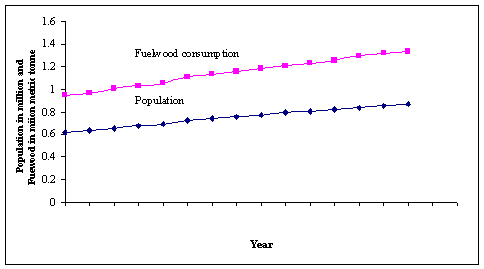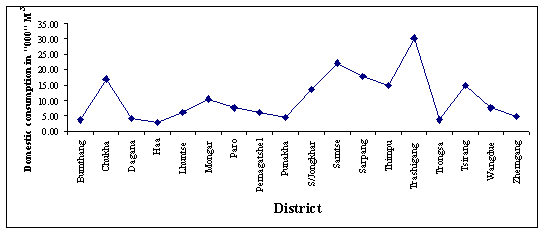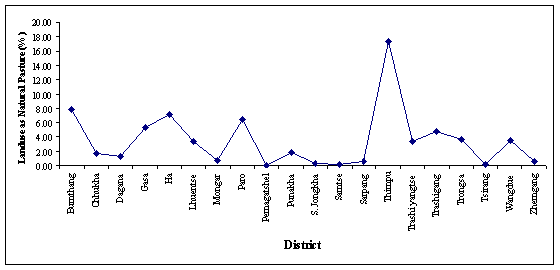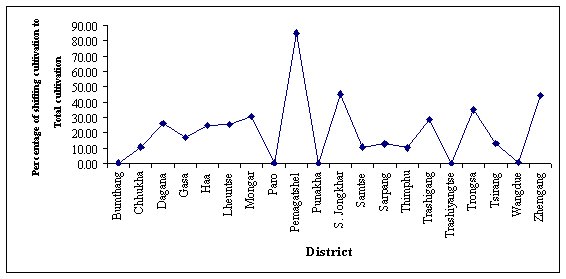


This chapter provides information on the use of forests for its various resources, such as, firewood, timber, and other marketed and non-marketed goods including pastures, and shifting cultivation, wooden industries in Bhutan.
At the national level, Bhutan is a forest sufficient state but not at the local level due to degradation in some places. State responsibility for forest management under the Forest Act, 1969 has increased the dependency of local people on the government for forest resources. The value of self-reliance, group effort and customary regulation is declining with increased control of the state to provide forest products and enforce laws and regulations. The forests are used for variety of purposes like fuel, timber, pasture, shifting cultivation, shingles, splinters, sokshing, medicine, dyes, water and religious activities. The main economic use of forests in Bhutan is use of water for hydropower generation.
Bhutan is self sufficient in per capita availability of firewood at the national level. However, at the village level, the availability of firewood falls short than the requirement due to the concentration of settlement in the valleys and other favourable locations. This can impose extra stress on the forests near settlements, leading to fragmentation and degradation. Lack of address of this problem in the current and future five years plans is likely to increase this dependency of households on forests for firewood.
Most forests in proximity of human habitations are now confined to the periphery of the gewogs as small patches, interspersed with shifting cultivation areas and pastures, and are distantly placed from large blocks of forest. The pressure on forests close to the gewogs is rising following population growth of almost 3 percent per annum and the establishment of fruit orchards. The availability of firewood is declining in these areas so much so that by the end of Five Year Plan IX a large part of Bhutan may face firewood scarcity (FAO, 1991).
The social and economic transformation of Bhutan is clearly illustrated by the changing mode of firewood collection. In the past, the firewood collection was often a group effort, based on the concept of mutuality and reciprocity of labour and not on cash transaction, and the neighbours used to take care of each other's needs for firewood requirements. Presently, group collection of firewood is becoming uncommon and has since been transformed from a social activity to an individual household activity (Wangchuk, 1998).
Legal regulation provides a permit system for felling trees to collect firewood, but the Forest Department does not have sufficient capacity to adequately regulate cutting leading to some illegal extraction of firewood. A study estimates that about 90 percent of the total firewood extraction in Bhutan is unregulated (FAO, 1991). This unregulated removal of firewood is further aided by cumbersome two stage system of procuring trees for firewood; first procuring approval of trees for felling for firewood and second getting the approved number of trees marked for felling in the forest. In most of the cases observance of the rules ends at the first stage because it is beyond the capacity of forest department to cover all the rural areas for marking of trees within the stipulated time. Therefore, after getting approval, the villagers begin felling the trees on their own and the number of trees they fell may exceed the approved number. This is very likely, as annual consumption of firewood of a household with an average family size of 5.5 persons is about 12 cubic meters equivalent to about 10 trees while the number of trees approved for felling is about 5 (Wangchuk, 1998).
The per capita annual fuelwood consumption is about 1 million and may soon (by the year 2005) reach or exceed the sustainable annual yield limit of 1.18 million m3 (MPFD, 1991) for "total" wood production in the country from operable areas (Annex 4, Table A4.1). Firewood extraction and the sustainable management of forests at the local level is a critical forest management problem. The Forest Department has to address both the demand and the supply aspects of firewood with limited manpower for regulating cutting and supply over a large area of rugged terrain.
Estimates of fuelwood consumption vary from study to study (PIS, 1980; Johnson, 1987; DOP, 1990; Save the Children 1991, FAO, 1991) due to variation in study design and implementation. The FAO study (1991) has considered all the earlier studies to arrive at its base estimates for 1997-1998 for developing projections for future consumption.

Fig 16. Projections of fuelwood consumption and population growth
This report revises the FAO (1991) projections on the basis of the population growth rates assumed by the Ministry of Planning (VIIIth FYP, 1998) for VIIIth to Xth five year plans. These projections (Annex 4, Table A4.1) differ slightly from FAO (1991) because of differences in population levels, growth estimates and the demand projection for "other sectors". The "other sectors" in FAO (1991) includes 5 sub-sectors (wood charcoal, agricultural and forestry activities, lemongrass extraction, miscellaneous activities, and unspecified activities). FAO (1991) provided for temporal growth in consumption only for the last three activities and held the consumption level of first two activities constant. This report provides growth in all the five sub-sectors of the "other sectors". Fig. 16 presents revised projections of the total fuelwood consumption in Bhutan.
In the past, villagers enjoyed the benefits of group social effort in the collection of timber for house construction. The whole community would help the person constructing the house through contribution of free labour or sometimes by payment in kind. This pattern has changed even more quickly and drastically than in the case of firewood collection. Relationships are now more often defined by the exchange of money than by the concept of reciprocity of labour. The impact of this social change varies inversely with the socio-economic status of the household because of high timber prices and low wages.
The demand for construction timber in the domestic sector is not well documented. One study (MPFD, 1991) indicates that per capita consumption is 0.29 m3 and projected demand is about 0.19 million m3 per year, (Annex 4, Table A3.2). Figure 17 presents the consumption of timber at district level.

Fig. 17. Domestic consumption of timber
Less than 20 percent of the demand of timber is met from regulated cutting in forest management units while the rest is met through ad-hoc felling by the Forest Department and by villagers in nearby forests (Wangchuk, 1998).
The majority of the households as well as nomadic pastorialists use pastures. There is lot of variation (Fig. 18) in the extent of pasture land in the districts (Annex 4, Table A4.3). The Land Act of 1978 defines access to and use of pastures. The ownership pattern of pastures has influenced the present patron-client relationship. Pasture is an important and highly contested resource since they are scarce and difficult to share without affecting the quality. Ownership of pasture becomes crucial, at times of the year when the area available for grazing is drastically reduced.

Fig. 18. Status of natural pastures in different districts
Ura (1993) in "The Nomad's Gamble" describes the patterns of pasture use and cattle movement by the people of Bumthang Dzongkhag. Similarly Gyamthso (1996) presents pasture ownership and use patterns in Laya. The old system of tsarin (payment for grass/fodder), between the pasture owner and the pasture user is still in existence. Pasture users make annual payments of a fixed quantity of butter and cheese to the pasture owners, for example, in Bumthang Dzongkhag.
Shifting cultivation in Bhutan is practised on about 88,300 ha. (LUPP, 1997). It is a system of subsistence agriculture that involves clearing forests, cultivating the land for few years and then leaving the land fallow. The practice of shifting cultivation is concentrated in the sub-tropical and upland broadleaf forest types. Shifting cultivation among 20 dzongkhags varies from negligible to about six times the amount of permanent cultivation (Annex 4, Table 5). Figure 19 shows the range of variation in area under shifting agriculture.
The use and distribution of shifting cultivation is influenced by remoteness and the absence of market outlets for agricultural products. It is difficult to state that the practice is rooted in the culture because of the ease with which the practice is changed for another type (permanent agriculture) or to suit alternative sources of food supply.
The extent of shifting cultivation in any season depends on the availability of labour and the food requirements of the household. It provides the cultivator with the ability to hedge against damage or seasonal variations in agricultural production. This flexibility causes substantial differences between the area actually under shifting cultivation and what is recorded as shifting cultivation.

Fig. 19. Extent of shifting cultivation
The government desires to phase out the current system of shifting cultivation as early as possible. The National Assembly of Bhutan in 1986 reaffirmed its resolution that if tseri or pangzhing land was left fallow beyond twelve years it would automatically revert to government forest. The government has provided a ban on additional clearances of forest for shifting cultivation through a new Act (Forest and Nature Conservation Act 1995). This act, however, provides that shifting cultivation can only be continued at the forbearance of the state.
The traditional mode of extraction of wooden shingles and splinters as a social activity is declining with time. Organizing such an effort is complex and depends on the distance and access to coniferous forests (mostly of fir) and transportation arrangements. Traditionally, the work was based on reciprocity, but transformation of a group effort to an individual effort has hit resource-poor household harder than resource-rich households. It has become difficult to obtain shingles unless they are paid for in cash. Many households now use corrugated tin sheets or slates in place of shingles, which have become an indicator of social status.
The extraction of pine splinters was once an important activity before the introduction of kerosene and electricity. Pinewood affected by fungus and high in pitch content was extracted in the form of splinters and used for lighting. Now pine splinters are sparingly used in times of electricity failure or kerosene shortages.
Sokshing means a government forest registered in an individual's name for collection of leaf litter. Sokshing is a local resource management institution and perhaps as old as farming in Bhutan (Wangchuk, 1998). While the leaf litter and pine needles keep the cattle warm in winter in their sheds, the decomposed material also makes ideal fertiliser, thereby contributing to food production.
New legal provisions are gradually transforming sokshing from a private to a public resource. Prior to the Forest Acts of 1969 and 1995 and the Land Act, 1978 the person who registered sokshing in his name owned it. The Forest Act defines sokshing as forest but is not explicit about its ownership. This gap is filled by the Land Act of 1978, which states that sokshing is a "forest to be used as a source of leaf litter and fodder and the owner has no right over the standing trees and land over which sokshing is established". Accordingly, the firewood from Sokshing can be taken out only on a permit from the Forest Department.
The percentage of individuals in a village possessing sokshing varies across dzongkhags and gewogs. The sokshing "ownership/possession" mostly follows the pattern of agricultural land but their role (social, forest product supplier, etc.) and extent differs depending on their location. The perceived value of the sokshing also varies depending on the current or expected scarcity of or distance to public forest resources. The past inheritable nature of sokshing has resulted in a high degree of fragmentation. Further, with the increasing monetization and modernization of the Bhutanese society, the sokshings are also becoming a source of conflict and theft in the gewogs. The change of ownership from the individual to the state has left little incentive for individuals to protect and plant additional trees.
Past care provided to sokshings by their owners can be compared with the adjoining government forests. While most of the sokshings are growing well, the government forests are often degraded. Local silvicultural practices for managing sokshings have evolved over many years and people know the needs of different species for management and harvesting (Wangchuk, 1998).
Bhutanese traditionally use plant material from different species for dyeing woven cloth. For example, the roots of the yungka (turmeric plant) are dried and pounded to produce a yellow colour. Tsoe (red colour) and shungkeyshing's tshoser (yellow colour) are mixed in equal proportions to produce leewang (orange color). Rhus, Strobilanthes and Prunus species are commonly used as dyes. Lac, produced by Ziziphus species (khanglayshing) is used to ensure the permanence of the dye. The research unit of the Forest Department has documented the plants that are used for dying thread. However, with the decrease in the availability of plant material local people are adopting artificial chemical dyes.
The wood-based industries in Bhutan are very important because they are second largest revenue earner for the government after hydropower (Wangchuk, 1998). However, much of the industry is at an early stage of development and often uses old technology. Most industrial units are small and utilizing local sources of supply. The total annual intake of the wood based industry is in the range of 100,000 to 200,000 cubic meters.
The majority of the industry is small sawmills. There are only two medium-sized industries, one an integrated sawmill, plywood and joinery factory and the other a medium size particleboard factory. There is no accurate information about the state of operation of the mills. The raw material (wood) prices in many cases are fixed by government to sustain and develop the industry. For example, the broom handle industry gets wood at subsidized prices to earn foreign exchange while the building industry is provided sawnwood at subsidized prices to discourage the use of roundwood.
About 49 sawmills concentrated in the western and southwestern of Bhutan produce about 75 to 80 percent of the "total" sawnwood. A typical Bhutanese sawmill has an input capacity of 10 to 20 m3 per day or about 4,000 -to 5,500 m3 per annum. The rated capacity, with a recovery rate of 50-55 percent, would be about 1,750 to 2,500 m3 per annum, but the capacity utilization rate is often as low as 25 to 30 percent (MPFD, 1991). About eight sawmills produce tea chest battens or other kinds of crates or boxboards. The tea chest battens are usually sold through a middleman who provides the needed materials, such as plywood, etc., from others sources.
Some sawmills are also producing blackboards and slate frames. In addition, there are about 33 units engaged in making local furniture with limited opportunities for hard currency due to the type of furniture and their expensive transportation.
About three companies produce broom handles for the European market. The industry uses prime quality fir as raw material. The government has subsidized prices (39 percent under the average price of the last six auctions) because it earns hard foreign currency. This industry can only survive with subsidized raw material due the large amount of waste in production and tight specifications.
Many cottage industries utilize non-wood raw material from forests to serve special markets within and outside the country. Resin tapping and lemon grass oil distillation have become important activities in the eastern part of the country. The government considers cottage scale industries as an important means through which the economic standard of the Bhutanese people can be raised.
About 300 out of 600 identified medicinal species in Bhutan are commonly used to prepare drugs. Certain minerals from the forest (belzab, chingsi, chuigang, dhojui, dho-phawang, dragshum, thingsi, tsage tsang, etc.) and animal parts are incorporated in the drugs for the Bhutanese system of medicine called gso-ba-rig-pa.
Lemon grass (Cymbopogon flexousus) is one of the most important essential-oil-bearing plants found in Bhutan. The Tashigang and Mongar districts have large areas under lemon grass production. The essential oil companies buy lemon grass collected from the wild areas at the roadside for their distillation units.
The resin from chir pine is collected in the central and eastern parts of Bhutan. The resin and turpentine factory in Samdrup Jongkhar processes this resin. The capacity of the processing plant is 300 tonnes of resin per annum. The production output is 78 percent resin, 14 percent turpentine and 8 percent waste. All products are exported and sold to India.
Waxes are derived from the seeds of Rhus verniciflua and Rhus syccdanea. Other sources are beeswax from beehives and sticklac produced by the tiny insect called lac. The bark of Daphne papyracea and Edgeworthia gardneri is used for paper making by many small family owned units. The paper from Edgeworthia gardneri is softer. Shitake (Lentinus edodes) mushrooms are famous and are cultured and marketed locally as well as abroad. The National Mushroom Project also cultures Agaricus, Pleurotus and Shiitake. The Project sells spawn to farmers and helps them to market and sell their produce. There is a ready market as production is far below demand.
Pinus roxburghii, Castanopsis hustrix, Ficus cordata, Bambusa species, Musa species, Oroxylum species, Rhus species, Cymbopogon species, Artemisia species and Quercus species are the main species used for religious purposes. These species are used for performing rituals, mostly of Bon origin, such as the one in Radhi Gewog known as Mingchang, performed usually every year for the general welfare of the household or an individual who may be sick at the time of the performance (Wangchuk, 1998). A local shaman, whose role is usually inherited, carries out this ritual. Although these species are used in rituals, there is no special spiritual attachment to these species. They can be as used as firewood or for other purposes like any other forest species.
Sacred trees and forests are protected and not harvested. For example, the trees planted around lhakhangs, chortens, community centres, and resting places along trails are considered to be sacred and are not cut or harmed. It is a common belief that local deities and evil spirits inhabit these forests. This is also true for mountains, rocks, etc.
The people do not destroy religious trees or sacred forest or do anything forbidden by the local religious persons. Even a small patch of well-stocked sacred or religious forest can be in existence for many generations in the vicinity of a forest area that has been completely degraded (Wangchuk, 1998). Religious influence also seems to have restrained people from deliberately setting fire to the forest to obtain new grass shoots for their cattle.
Forest conservation is essential for the sustainable generation of hydropower. The country's large hydropower potential, estimated at 20,000 megawatts, can only be effective if the forests in the catchments of the rivers are adequately conserved. Implementation of proper watershed management plans, including biological diversity conservation programs, can contribute to the sustainability of this very important source of income for the country. This is important because all existing and planned hydropower plants are based on a run-of-the-river system that takes advantage of the natural fall of the rivers to generate power. Most of these rivers originate from lakes in the northern part of the country that are fed by catchments in forested areas. The forest cover defines the water holding capacity and silt contribution of the catchment.
The hydropower sector is the largest contributor to the country's exchequer. During the VIIth Five Year Plan (FYP), the power sector accounted for 25 percent of the government's revenue. The conservation of watersheds for hydropower generation is of high priority due to the projection of a growth rate of 7 percent per annum for the power sector during the VIIIth FYP. Two major hydropower plants - Basochu and Kurichu - are under construction and will be commissioned during the VIIIth FYP. Two more hydroelectric plants (Tala Hydroelectric Project with a planned capacity of 1 020 megawatts and the Bunakha Reservoir Scheme with 180 megawatts) are also contemplated for in the current VIII FYP.
Forest use in Bhutan is intimately linked with traditional practice and culture. It is an integral part of farming system. Some uses are better documented (fuelwood) than others (non-wood products). Current fuelwood consumption has almost reached the level of the total annual sustainable cut. Dependence of local people on the government for forest resources is increasing following enactment of Forest Act, 1969. The value of self-reliance, group effort and customary regulation is declining with an increase in the capacity of the state to provide products and enforce legislation. At the national level, Bhutan is a forest sufficient state but at the local level this is not the case leading to degradation. Increasing population and income are putting additional demands on forest resources.
Hydropower electricity generation in Bhutan is increasingly becoming synonymous with economic development because of its immediate positive impact on the country's balance of payments and future development. However, the large hydropower potential can only be realized if the forests in the catchment areas of the rivers are adequately protected.